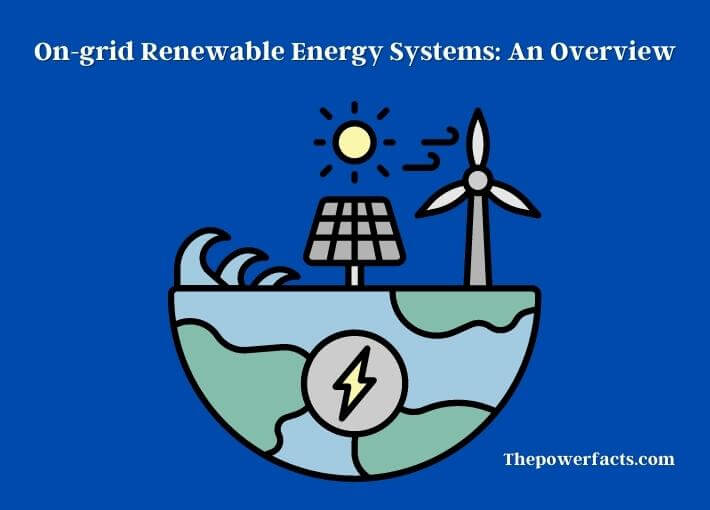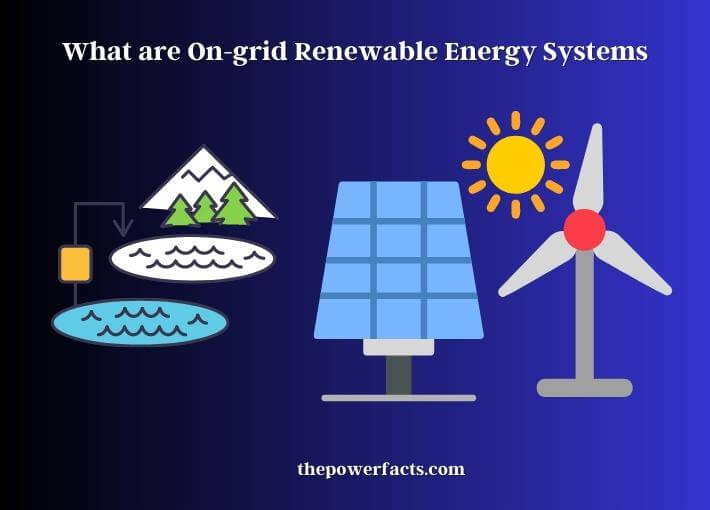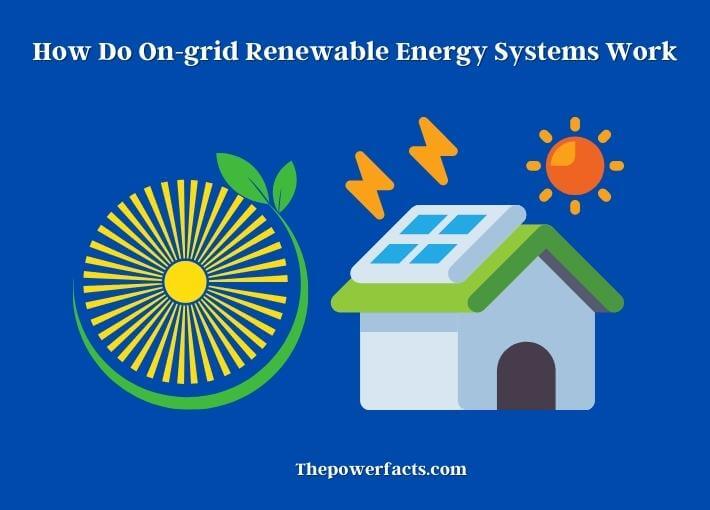Published on: March 24, 2023
Written by Jonas Frank / Fact-checked by Nova Scarlett
On-grid renewable energy systems are becoming increasingly popular due to their numerous benefits over traditional power generation methods. As the world continues to face challenges related to climate change, there is a growing need to shift toward sustainable energy sources. On-grid renewable energy systems are an excellent option as they not only provide a cleaner and more environmentally friendly source of energy but can also help reduce energy bills and reliance on grid electricity.

We will provide an in-depth look at on-grid renewable energy systems, including how they work, the different types available, the advantages and challenges associated with them, and the factors to consider before installing one. We will also discuss the various components of an on-grid renewable energy system, how to design and install one, and the maintenance and repair required to keep it running efficiently.
What are On-grid Renewable Energy Systems?
On-grid renewable energy systems, also known as grid-tied renewable energy systems, are designed to generate electricity from renewable sources such as solar, wind, and hydropower. These systems are connected to the main power grid and work in conjunction with it, allowing excess energy to be fed back into the grid and reducing the need for non-renewable sources of energy.
The main components of an on-grid renewable energy system include solar panels or wind turbines to generate electricity, an inverter to convert the DC power generated into AC power that can be used in homes or businesses, a meter to measure the energy produced and consumed, and a switch to disconnect the system from the grid during maintenance or repairs.

On-grid renewable energy systems are becoming increasingly popular due to their ability to provide a clean and sustainable source of energy while also reducing energy bills and reliance on traditional power generation methods. They are particularly useful in areas with abundant sunshine or wind, where they can generate a significant amount of energy and provide a reliable source of electricity.
How Do On-grid Renewable Energy Systems Work?
On-grid renewable energy systems work by harnessing the power of renewable sources to generate electricity. The electricity generated is then sent to the main power grid, where it is distributed to homes and businesses. The system is made up of several components, including:

The electricity generated by on-grid renewable energy systems is sent to the main power grid through a bi-directional meter. This meter measures the amount of electricity consumed and produced, allowing users to be credited for any excess electricity produced.
Types of On-grid Renewable Energy Systems
There are several types of on-grid renewable energy systems that users can choose from.
Solar Photovoltaic Systems
Solar photovoltaic systems use solar panels to convert sunlight into electricity. They are easy to install and can be used in both residential and commercial settings.
Wind Turbine Systems
Wind turbine systems use wind energy to generate electricity. They are typically installed in areas with high wind speeds, such as coastal regions.
Hydroelectric Systems
Hydroelectric systems use the energy from falling water to generate electricity. They are typically installed near waterfalls or other sources of falling water.
Biomass Systems
Biomass systems use organic matter such as wood chips, agricultural waste, or even garbage to generate electricity. They are often used in rural areas where there is an abundant supply of organic matter.
Geothermal Systems
Geothermal systems use the natural heat of the earth to generate electricity. They are typically installed in areas with high geothermal activity, such as volcanic regions.
Advantages of On-grid Renewable Energy Systems
On-grid renewable energy systems offer several advantages over traditional fossil fuel-based electricity systems.
| Reduced Electricity Bills | On-grid renewable energy systems can significantly reduce electricity bills as users can produce their electricity, reducing their reliance on the main power grid. |
| Lower Carbon Footprint | On-grid renewable energy systems produce electricity from renewable sources, resulting in lower greenhouse gas emissions and a lower carbon footprint. |
| Increased Energy Independence | On-grid renewable energy systems provide users with energy independence as they can generate their electricity, reducing their reliance on external sources. |
| Improved Resilience | On-grid renewable energy systems can continue to function during power outages, providing users with a reliable source of electricity. |
Disadvantages of On-grid Renewable Energy Systems
On-grid renewable energy systems also have some disadvantages that users need to consider.
| Initial Cost | On-grid renewable energy systems require an initial investment, which can be quite expensive. However, this cost can be offset by reduced electricity bills in the long run. |
| Weather Dependence | On-grid renewable energy systems rely on renewable sources such as sunlight and wind, making them weather-dependent. During periods of low sunlight or wind, the system may not generate enough electricity to meet demand. |
| Grid Dependence | On-grid renewable energy systems are still dependent on the main power grid, meaning that users may still experience power outages if there is a fault in the grid. |
Factors to Consider Before Installing On-grid Renewable Energy Systems
Before installing on-grid renewable energy systems, there are several important factors that users should consider. These include:
Energy Needs
Users should evaluate their energy needs carefully to determine the size and type of renewable energy system required. Factors to consider include the number of appliances and devices that will be powered, as well as any seasonal variations in energy usage.
Location
The location of the installation site is an essential consideration. Factors to consider include the availability of sunlight, wind speeds, and access to water or organic matter. Users should also consider any local regulations or permits required for the installation of renewable energy systems.
Budget
The cost of installing an on-grid renewable energy system can vary widely depending on the type and size of the system, installation costs, and other factors. Users should carefully evaluate their budget and consider long-term cost savings when selecting a system.
Maintenance
Regular maintenance is necessary to ensure that the system is functioning correctly and to address any issues that may arise. Users should be prepared to invest time and resources in maintaining their renewable energy system to ensure that it continues to operate efficiently.
Backup Power
On-grid renewable energy systems are still connected to the main power grid, which means that users may experience power outages during grid faults. Users should consider installing a backup power system, such as a battery backup or backup generator, to ensure continuity of power supply.
Expertise
Installation and maintenance of on-grid renewable energy systems require specialized skills and knowledge. Users should work with a qualified installer who can ensure that the system is installed correctly and safely.
By carefully considering these factors, users can select an on-grid renewable energy system that meets their energy needs, fits their budget, and is reliable and efficient.
Components of On-grid Renewable Energy Systems
On-grid renewable energy systems typically include several key components that work together to generate and distribute electricity.
- Solar panels or wind turbines – These components capture energy from the sun or wind and convert it into electrical energy (here are some forms of electrical energy).
- Inverter – The inverter converts the direct current (DC) electricity produced by solar panels or wind turbines into alternating current (AC) electricity that can be used by appliances and devices.
- Battery (optional) – If the system includes a battery, it can store excess energy generated by the solar panels or wind turbines for later use when there is no sun or wind.
- Meter – A meter is used to measure the amount of electricity generated by the renewable energy system and the amount of electricity consumed by the household.
- Switchboard – The switchboard is used to control the flow of electricity between the renewable energy system and the power grid.
- Power grid – The on-grid renewable energy system is connected to the main power grid, allowing excess electricity to be fed back into the grid when it is generated and used when it is needed.
- Monitoring system – A monitoring system is used to track the performance of the renewable energy system, including energy generation and consumption, to ensure that it is operating efficiently.
How to Maintenance and Repair On-grid Renewable Energy Systems?
Regular maintenance is essential to keep an on-grid renewable energy system operating efficiently and to prevent costly repairs.
Regular Cleaning
Solar panels or wind turbines should be cleaned regularly to remove dirt, dust, and debris that can reduce their efficiency. Use a soft cloth and mild detergent to clean the surface of solar panels, and a soft brush or sponge to clean the blades of wind turbines. Solar panels need to be cleaned about once a month in order to continue working properly.
Inspection
Regular inspection of the system can identify any potential issues and prevent costly repairs. Inspect the wiring and connections to ensure they are secure and free of damage. Check the battery for signs of damage or corrosion, and inspect the inverter for any visible signs of wear or damage.
Upgrading
As technology advances, newer and more efficient components may become available. Consider upgrading your system to take advantage of the latest technology and improve efficiency.
Repairs
If a component of the system is not working correctly, it may need to be repaired or replaced. Always work with a qualified installer or technician to repair or replace any components of the system.
Warranty
Many renewable energy system components come with a warranty, which can cover the cost of repairs or replacements. Be sure to keep records of any warranties and contact the manufacturer or installer if you believe there is a problem with a component covered by the warranty.
Safety
Always follow safety procedures when maintaining or repairing the renewable energy system. Turn off the power to the system and wear appropriate personal protective equipment to avoid electrical shock or other hazards.
Costs of On-grid Renewable Energy Systems
On-grid renewable energy systems can be a significant investment for homeowners, but they can also save money in the long run by reducing electricity bills and providing a reliable source of clean energy. The cost of an on-grid renewable energy system can vary depending on a variety of factors, including the type of system, location, and size.
The cost of an on-grid renewable energy system depends on the type of system installed. Solar panel systems are typically less expensive than wind turbines or hybrid systems, but they may not be as effective in areas with limited sunlight.
The location of the home can also impact the cost of an on-grid renewable energy system. Areas with high wind speeds or abundant sunlight may require fewer panels or turbines, reducing the overall cost.
The size of the renewable energy system also impacts the cost. Larger systems can generate more electricity, but they may also be more expensive to install.
The cost of installation can also vary depending on the complexity of the system and the qualifications of the installer. Homeowners should work with a qualified installer or technician to ensure that the system is designed and installed correctly.
There may be rebates or incentives available to homeowners who install renewable energy systems. These can help offset the upfront costs of the system and provide additional savings.
How Do Pumped Storage Hydropower Projects Fit into On-grid Renewable Energy Systems?
Pumped storage hydropower systems are crucial in on-grid renewable energy setups. These projects store energy by pumping water uphill to a reservoir, then releasing it downhill through turbines to generate electricity during peak demand. This unique system helps balance the grid and support the integration of other renewable energy sources.
The Bottom Line
On-grid renewable energy systems are an excellent way to generate clean, renewable energy and reduce reliance on traditional fossil fuels. By installing a renewable energy system, homeowners can save money on their electricity bills, reduce their carbon footprint, and contribute to a more sustainable future.
Before installing a renewable energy system, it’s important to consider factors such as location, energy needs, and budget. Working with a qualified installer or technician can ensure that the system is designed and installed correctly for optimal performance.
Regular maintenance and repairs are also essential to keep the renewable energy system operating efficiently and prevent costly repairs. By following these tips and best practices, homeowners can ensure that their on-grid renewable energy system continues to provide clean, reliable energy for years to come.
On-grid renewable energy systems are an excellent investment for anyone looking to reduce their environmental impact and take advantage of the benefits of renewable energy. With the right planning, installation, and maintenance, renewable energy systems can provide clean, reliable energy for years to come.